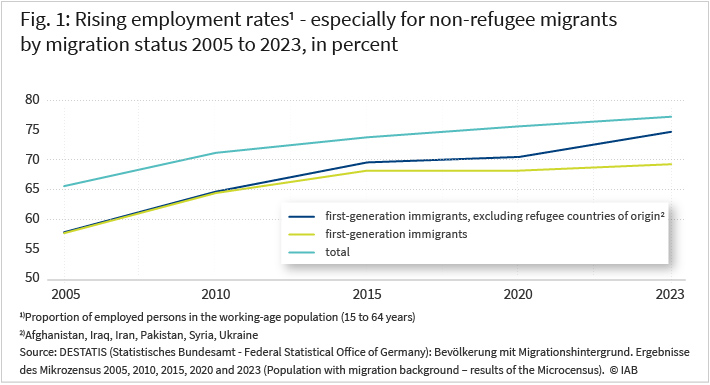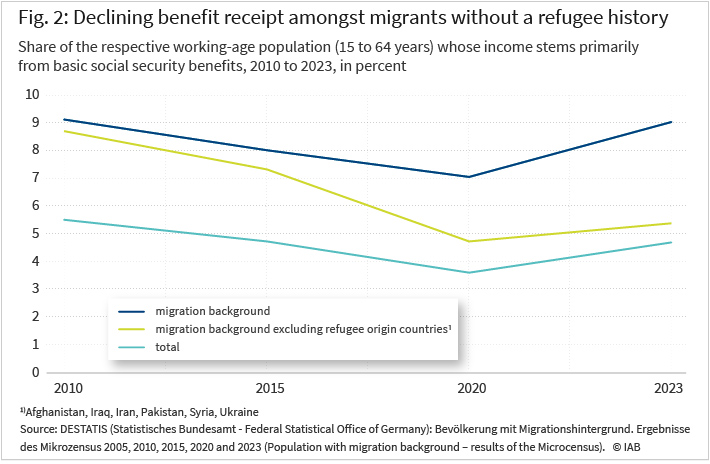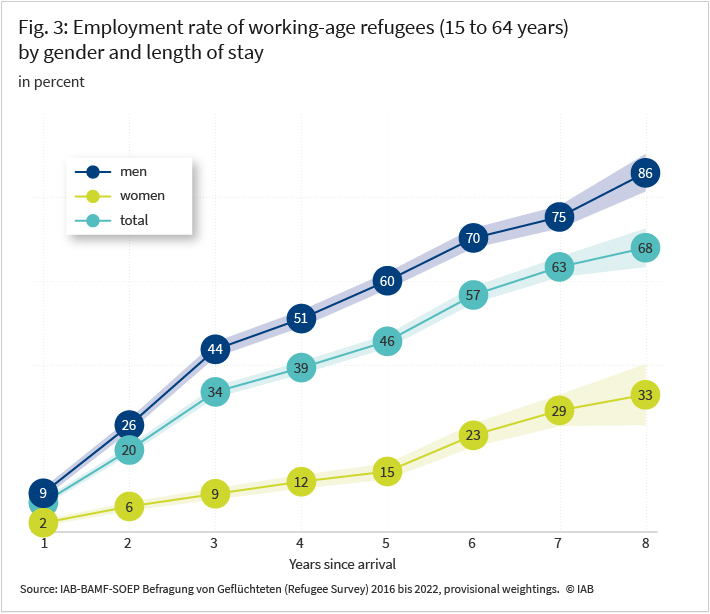31. July 2025 | Labour Market Policy
Drivers of employment growth: An overview of the integration of migrants into the German labour market

The IAB conducts extensive research on the topic of “migration and mean-tested benefits” in Germany. Here, an overview of selected current findings is provided.
The employment rates of migrants have risen substantially – although refugees integrate later into the labour market
- Since 2005, when the novel system of mean-tested benefits for the unemployed were introduced, the employment rate amongst migrants has increased from 58 to 69 percent in 2023. Over this period, the employment rate for the average population has also increased, from 66 to 77 percent (see Figure 1).
- The employment rate of migrants (excluding those from the main refugee countries of origin: Afghanistan, Iraq, Iran, Pakistan, Syria, and Ukraine) was 75 percent in 2023, compared to 77 percent for the population average.
- Although Germany has taken in significantly more refugees than most other EU member states, the employment rate of migrants was 70 percent in 2023, above the EU average of 66 percent. This suggests that migrants coming to Germany overwhelmingly want to work.
Sources: DESTATIS, Population with a migration background. Results of the microcensus, various editions; OECD 2024.

Employment growth bolsters the welfare state’s revenues
- The number of employed persons in Germany increased by 6.1 million (17 %) between 2005, the year in which the new system of mean-tested benefits for the unemployed were introduced, and 2023 (see Table). This was a major contributing factor to the significant increase in tax- and social-security contributions in Germany during this period. This had a positive fiscal impact on age-related social security systems (pensions, long-term care, health insurance), but also contributed, on the revenue-side, to the tax funded mean-tested benefit system as well as to the contributions to the unemployment insurance.
- This employment growth is due to the increase of people with a migration background in employment (+6.3 million employed persons; corresponding to a 116 percent employment increase).
- Due to the declining number of employed persons without a migration background, the total number of employed persons in 2023 only grew thanks to foreign workers. Similarly, a future increase in employment – and thus the strengthening of the welfare state’s financial base – will hardly be achievable without migration.
Source: DESTATIS, Population with a migration background. Results of the microcensus, various editions; OECD 2024.

The rate of benefit-receipt amongst migrants is trending downwards, but strong refugee-migration in 2015 and 2022 interrupted this trend
- The increase in employment by 6.1 million people due to migration is accompanied by an increase in unemployment expenditures, particularly the growth of mean-tested benefits for the unemployed – the so-called “Citizens’ Benefit” under the Social Code II (SGB II).
- The number of people with a migration background whose income comes primarily from mean-tested benefits under the SGB II rose from 1.2 million in 2010 to 2.1 million in 2023, driven mainly by refugees fleeing to Germany. It is important to note that the population with a migration background more than doubled during that time. The proportion of people with a migration background whose income comes primarily from benefits under the SGB II declined slightly from 9.3 to 9.2 percent over the same period (see Figure 2).
- The proportion of people whose income comes primarily from mean-tested benefits under the Social Code II (SGB II) fell from 8.7 to 5.4 percent amongst migrants without a refugee history during the same period. This proportion is only slightly higher than that in the population average in Germany.
- This trend is also confirmed by statistics from the Federal Employment Agency (BA): The number of minimum income recipients who are able to work fell from 4.2 million to 3.9 million between 2014 and 2023. If persons from the main countries of origin of asylum seekers and Ukrainians are excluded, the number fell to 2.9 million.
Sources: DESTATIS, Microcensus and BA statistics, own calculations.

Who claims mean-tested benefits for the unemployed (“Citizen’s Benefits”)?
- Around two-thirds of unemployed recipients of mean-tested benefits (“Citizens’ Benefits”) who are able to work have no vocational qualification In 2022, 19.1 percent of young adults aged 20 to 34 in Germany had no vocational qualification. This represents 2.86 million people.
- Amongst those without a vocational qualification, there is an above-average number of foreign nationals in 2021: While 11.7 percent of 20- to 34-year-olds with German citizenship had no vocational training, the rate was three times as high among their foreign peers, at 38.1 percent. However, the averages are not entirely comparable because many foreign nationals are new immigrants and many are still in education and training.
- The differences are also due to discrepancies in the education systems of the countries of origin, which generally do not have a dual vocational training system. The informally acquired skill level might be therefore higher than the level of degrees suggest. Note that the differences in school-level qualifications between German nationals and foreign-born migrants are much smaller than differences in vocational degrees.
- And yet, differences in vocational qualifications alone do not explain the differences in benefit receipt. While people with no vocational qualifications who immigrated to Germany with a residence permit for employment purposes have, on average, lower benefit receipt rates than German citizens. The benefit receipt rates of university graduates who came to Germany as refugees are higher than those of other migrants without vocational qualifications.
- Overall, the unemployment rate for people without vocational qualifications was 19.8 percent in 2022, much higher than the population average, as were the employment risks for this group, as unstable work leads to the “revolving-door” effect in and out of employment. Having no vocational qualifications also increases the risk of becoming long-term unemployed in Germany: 60 percent of the long-term unemployed have no vocational qualifications.
Refugees integrate more slowly into the labour market, but employment rates converge with the length of stay
- Due to the individual impacts of war, persecution and flight, refugees often integrate more slowly into the labour market than other migrants. Further barriers include a poorer match between their education or training and labour-market requirements in Germany, as well as institutional barriers such as employment bans, asylum procedures and residency requirements.
- However, employment rates converge with those of other migrant groups and the population average over time: Eight years after arrival, 68 percent of refugees are employed (see Figure 3). The employment rate for men eight years after arrival is even higher than that of the general population.
- Labour-market integration can be accelerated through faster asylum procedures; early and better language training; the removal of institutional barriers such as residency requirements; increased placement- and job-integration efforts; and the reduction of discrimination.
- Nevertheless, the labour-market integration of refugees will always be slower than that of other migrant groups and will be a net fiscal loss for the welfare state at least in the initial phase. However, providing shelter and the integration of refugees is a humanitarian task. The fiscal balance improves in the longer term and may even become positive after a certain period of staying in Germany.
Sources: IAB Brief Report 10/2024; IAB Research Report 12/2024.

References
Brücker, Herbert; Ehab, Maye; Jaschke, Philipp; Kosyakova, Yuliya (2024): Arbeitsmarktintegration von Geflüchteten: Verbesserte institutionelle Rahmenbedingungen fördern die Erwerbstätigkeit. IAB-Kurzbericht No. 10.
Brücker, Herbert; Ehab, Maye; Jaschke, Philipp; Kosyakova, Yuliya (2024): Institutionelle Hürden beeinflussen Umfang und Qualität der Erwerbstätigkeit von Geflüchteten. IAB-Forschungsbericht No. 12/2024.
DESTATIS (Statistisches Bundesamt – Federal Statistical Office of Germany): Bevölkerung mit Migrationshintergrund. Ergebnisse des Mikrozensus 2005, 2010, 2015, 2020 and 2023 (Population with migration background – results of the Microcensus). Wiesbaden.
picture: TommyStockProject/stock.adobe.com
DOI: 10.48720/IAB.FOO.20250731.02
Brücker, Herbert (2025): Drivers of employment growth: An overview of the integration of migrants into the German labour market, In: IAB-Forum 31st of July 2025, https://iab-forum.de/en/drivers-of-employment-growth-an-overview-of-the-integration-of-migrants-into-the-german-labour-market/, Retrieved: 23rd of December 2025
Diese Publikation ist unter folgender Creative-Commons-Lizenz veröffentlicht: Namensnennung – Weitergabe unter gleichen Bedingungen 4.0 International (CC BY-SA 4.0): https://creativecommons.org/licenses/by-sa/4.0/deed.de
Authors:
- Herbert Brücker

 Prof. Dr. Herbert Brücker is Head of the Research Department for Migration, Integration and International Labour Studies at IAB.
Prof. Dr. Herbert Brücker is Head of the Research Department for Migration, Integration and International Labour Studies at IAB.